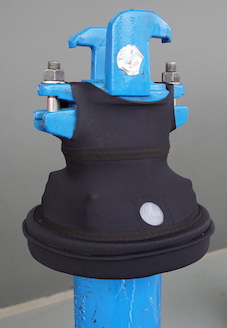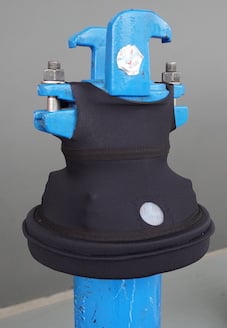Wetsuit-like material reduces maintenance costs of fire hydrants

While swimwear is usually reserved for the summer months, this isn’t always the case in Queensland – especially now that fire hydrants around the state are sporting trendy new togs in a bid to maintain asset life.
Urban Utilities is trialling a new ‘hydrant bikini’ that protects the asset from ants and debris, which could extend the life of hydrants and reduce maintenance costs.
The Australian-first trial of the technology will see the devices rolled out to around 100 sites across south-east Queensland.
Steve Ellwood from Urban Utilities’ infrastructure maintenance team presented the hydrant bikini at the company’s CEO Innovation Hour – a forum where employees share ideas for improvement.
“Urban Utilities maintains more than 100,000 fire hydrants across its region and invests around $6 million every year in maintaining, testing and renewing them,” Ellwood said.
“The significant cost of monitoring and cleaning these hydrant box cavities where below ground spring hydrants are located – which can fill with soil transported by ants – is a common challenge faced by utilities across the world and the hydrant bikini could be a solution.
Prevent soil transportation
The device was appraised by the Water Services Association of Australia following successful trials conducted by Urban Utilities at three sites from May 2019 to September 2020.
 The 'hydrant bikini' is a low-cost, simple cover made from wetsuit-like material with an adjustable ring down the bottom that can be put onto existing assets.
The 'hydrant bikini' is a low-cost, simple cover made from wetsuit-like material with an adjustable ring down the bottom that can be put onto existing assets.
Ellwood said the device offers a cost-effective and relatively simple barrier that is durable and easy to install.
“The bikini proved to be effective in preventing soil transportation by ants or water and other debris from entering the hydrant cavities, so we’re excited to expand the trial,” he said.
“It is a low-cost, simple cover made from wetsuit-like material with an adjustable ring down the bottom that can be put onto existing hydrants without turning the water off so they can be installed without interrupting supply for our customers.
“The neoprene rubber material will last for around 50 years and will give the hydrant a barrier to keep water, grass, ants and vermin out to protect the essential asset for years.”
Ellwood said the hydrant bikini will be trialled with the utility’s delivery partners, Downer and Utilita, over the next 12 months in order to ascertain where the new device will be included in long-term maintenance.
“If successful the technology may eventually be introduced as standard on our new hydrants and added to existing assets as part of our maintenance program,” Ellwood said.
